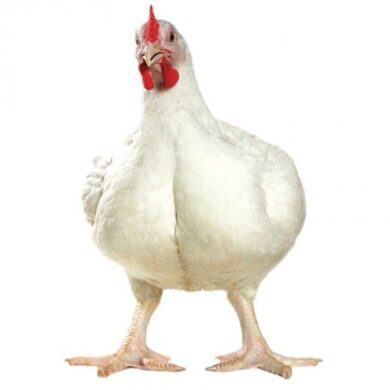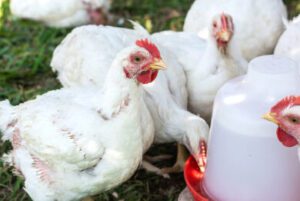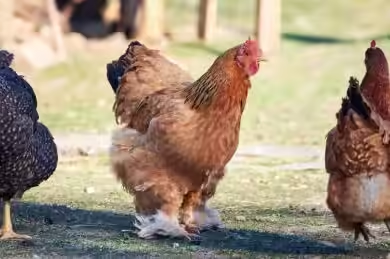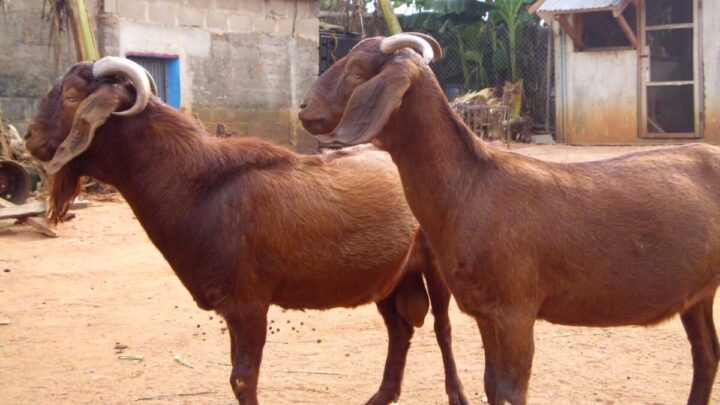Last updated on August 1, 2025
Welcome! If you’re looking for a profitable, fast-turnaround poultry venture, broiler farming is one of the best options in Nigeria. This guide is your complete A-to-Z blueprint for success.
Table of Content showIn This Guide, You Will Learn:
- The Full Broiler Growth Cycle: From day-old chick to market-ready in 6 weeks.
- A Step-by-Step Farming Plan: From planning and housing to daily management.
- Links to Expert Tools: Including our Feed Calculator and Medication Guide.
- Profit-Focused Marketing: How to successfully sell your live broiler chickens.
- Common Questions Answered: Including “Do broilers lay eggs?” and more.
Understanding the Basics of Broiler Chickens
Before we dive into the steps, let’s cover the fundamentals of what makes broilers a unique and profitable choice for farmers in Nigeria.
What Are Broiler Chickens?
Broiler chickens are a specific type of chicken that has been bred exclusively for rapid meat production. Unlike layers (bred for eggs) or dual-purpose breeds, a broiler’s entire genetic makeup is optimized to convert feed into body mass efficiently, making them ready for market in an incredibly short time.
Why Choose Broiler Farming?
- Quick Turnaround: This is the biggest advantage. A broiler is ready for market in just 5 to 7 weeks (35-49 days). This allows you to run multiple profitable cycles in a single year, ensuring steady cash flow.
- “The study further revealed that broiler farming is a profitable enterprise with profitability index of 39.85%.” — What are the Drivers of Profitability of Broiler Farms in the North-central and South-west Geo-political Zones of Nigeria?, Ahmadu Bello University ePrints
- High Demand for Meat: Chicken meat is a staple protein source in Nigeria. The demand from households, restaurants, and events is consistently high, creating a robust and reliable market for your product.
- “Poultry production offers a very fast and healthy approach to meeting the growing demand for animal protein.” — POULTRY SECTOR STUDY NIGERIA, Food and Agriculture Organization of the United Nations (FAO)
- High Feed Conversion Efficiency (FCR): Broilers are champions of feed conversion. Their FCR is typically around 1.5 to 1.7, meaning they only need about 1.6 kg of feed to gain 1 kg of body weight. This efficiency is key to managing costs and maximizing profit.
Key Characteristics of a Broiler
- Fast Growth Rate: A well-managed broiler can reach an average weight of 2.5 kg (5.5 lbs) in just 6 weeks.
- High-Quality Meat: They produce tender, juicy meat with high protein content, which is highly preferred by consumers.
- Limited Egg-Laying: A common question is, “Do broilers lay eggs?” The answer is rarely. They are not bred for egg production, and it is not a commercially viable aspect of broiler farming.
Broiler vs. Layer vs. Noiler: Are You Choosing the Right Chicken?
Before you commit to broiler farming, it’s crucial to be certain it’s the right choice for your specific goals. Here’s a quick overview of the main poultry types:
- Broiler: Your choice for the fastest possible meat production.
- Layer: The specialist for high-volume egg production.
- Noiler: A hardy, dual-purpose breed for both meat and eggs.
While this guide is your complete blueprint for raising broilers, understanding the full picture is essential. To see a detailed head-to-head comparison of all three breeds—covering profitability, growth timelines, and farming styles—read our ultimate guide on Broiler vs. Layer vs. Noiler. It’s the best resource to confirm if broilers are truly the best fit for you.

Step 1: Planning Your Broiler Farm & Business
Success begins long before the first chick arrives. Proper planning is the foundation of a profitable farm.
Setting Goals and Objectives
First, define your goals. Are you starting a small-scale backyard farm for your local community, or do you envision a larger commercial operation? Write down your objectives, your budget, and a realistic timeline. This initial plan will be your roadmap.
For a detailed guide on creating a formal, bank-ready document to secure loans or investments, read our Ultimate Guide to Writing a Poultry Business Plan.
Site Selection and Housing
Your location is critical. Look for land that is accessible, has a reliable water source, and is a safe distance from other poultry farms to minimize disease risk. Your housing should provide:
- Adequate Space: To prevent overcrowding and stress.
- Proper Ventilation: To ensure good air quality and prevent respiratory diseases.
- Protection: A secure structure that shields your birds from predators and extreme weather.
Step 2: Managing the Broiler Growth Cycle
Understanding the week-by-week needs of your broilers is key to successful management.
- Phase 1: Day-Old Chicks (Week 1): This is the most critical period. Chicks require a brooding temperature of 32-35°C (90-95°F), 24-hour lighting to encourage eating, and a high-protein (22-24%) starter feed.
- Phase 2: Early Growth (Weeks 2-3): Feathers begin to develop, and weight gain accelerates. Gradually reduce the temperature and transition them to a grower feed.
- Phase 3: Rapid Growth (Weeks 4-5): This is when major muscle development occurs. Feed intake will be at its highest. Ensure there is adequate space and a constant supply of finisher feed.
- Phase 4: Market-Ready (Weeks 6-7): The birds reach their target slaughter weight (2-3 kg). This is the time to perform final health checks before marketing.
Step 3: Broiler Nutrition and Feeding Strategy
Feeding is the biggest recurring cost in broiler farming. Getting it right is essential. A broiler’s diet is typically divided into three phases:
- Starter Feed: High in protein to kickstart growth.
- Grower Feed: Balanced nutrition to build muscle mass.
- Finisher Feed: Higher in energy to maximize weight gain before sale.
Estimating Your Feed Requirements
One of the most important questions you’ll ask is, “How many bags of feed do I need?” The answer depends on your flock size, the growth period, and the size of your feed bags. Because this calculation is so crucial for your budget, we have created a dedicated guide with an interactive tool to give you a precise answer.
- “Feed efficiency (FE) is an important economic factor in poultry production, and feed conversion ratio (FCR) is one of the most widely used measures of FE.” — Novel insight into the feed conversion ratio in laying hens and construction of its prediction model, PubMed Central (NIH)
Calculate Your Exact Feed Needs
How Many Bags of Feed for Broilers? (A Complete Calculator & Chart) Use our free tool to get an instant calculation for your exact flock size. It provides a full breakdown by feed type and includes downloadable charts. This is the most accurate way to budget your feed costs.
Step 4: Health, Medication, and Vaccination
For fast-growing broilers, proactive health management is essential for survival and profitability. Your strategy should be built on two key areas: biosecurity and strategic medication.
- Biosecurity: This means implementing strict hygiene protocols—like using foot dips and cleaning equipment—to prevent diseases from entering your farm.
- Medication & Vaccination: This involves knowing which vaccines are non-negotiable (like for Newcastle Disease) and having essential medicines on hand to treat common issues like Coccidiosis before they devastate your flock.
- “Vaccination is one of the most important aspects of poultry management. You must ensure you follow the scheduled vaccination programs to prevent disease outbreaks.” — Management factors associated with the survival and market weight of broiler chickens among small-scale farmers in the Dodoma City of Tanzania, PubMed Central (NIH)
Understanding the specific drugs, dosages, and withdrawal periods requires expert detail.
Your Essential Health Guide
Must-Have Medicines & Vaccines for Broilers in Nigeria Our complete guide lists the 4 essential medications every broiler farmer should have, a full vaccination overview, and safe administration practices. This is a must-read before you buy your first chick.
Common Broiler Diseases & Prevention (Quick Reference)
| Disease | Symptoms | Prevention |
|---|---|---|
| Newcastle Disease | Coughing, paralysis, high mortality | Vaccination at 7-14 days |
| Gumboro (IBD) | Swollen feathers, diarrhea | Vaccination at 10-14 days |
| Coccidiosis | Bloody droppings, weakness | Clean litter, anticoccidial drugs (Amprolium) |
| Fowl Pox | Scabs on comb, wattles | Vaccination at 3 weeks |
Step 5: Marketing and Selling Your Broilers
Production is only half the battle; you need a solid plan to sell your chickens.
- Selling Live Birds: Many farmers sell live broiler chickens directly from the farm gate to consumers, local restaurants, or market traders. Building relationships with these buyers is key to consistent sales.
- Using Pictures for Promotion: In today’s market, visuals are powerful. Share high-quality pictures of your healthy birds and clean farm on social media platforms (like WhatsApp, Facebook, or Instagram) to build trust and attract customers.
Frequently Asked Questions (FAQ)
Q: What is the difference between a broiler and a noiler?
A: A broiler is bred for fast meat production. A noiler is a hybrid that offers moderate growth for meat and can also lay some eggs.
Q: How many days does a broiler chicken take to grow?
A: Under optimal conditions, a broiler takes about 35 to 49 days (5 to 7 weeks) to reach market weight.
Q: At what age can broilers go outside?
A: It’s generally recommended that broilers are only allowed brief outdoor access after 3 weeks of age, once they are more robust and the weather is suitable.
Q: What is the ideal temperature for broiler chicks?
A: Day-old chicks require a brooding temperature of 32-35°C (90-95°F), which should be gradually reduced as they grow.
Q: How much space do broilers need?
A: Adequate space is crucial to prevent overcrowding and stress; typically, about 0.8-1 square foot per bird is recommended for market-ready broilers.
Q: What are the common signs of disease in broilers?
A: Signs include rough feathers, reduced feed intake, depression, huddling, respiratory symptoms (coughing, sneezing), and watery or bloody diarrhea.
Q: Is it profitable to start with a small number of broilers?
A: Yes, starting small can be profitable and allows you to gain experience before scaling up your operation.
Q: What is the biggest mistake new broiler farmers make?
A: The most common mistake is inadequate planning, especially with budgeting for feed, and poor biosecurity. Many new farmers underestimate feed costs or don’t take disease prevention seriously, which can quickly erase profits.
Conclusion
Starting a broiler chicken farm is a challenging but highly rewarding venture. By following a careful plan for housing, nutrition, health, and marketing, you can build a successful and profitable enterprise. This guide has provided you with the blueprint; now it’s time to take action.
Happy farming, and may your journey into broiler farming be a successful one!


